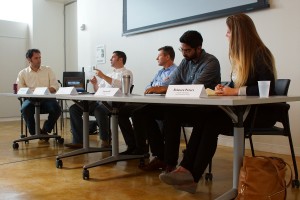 Author:
Author:
Javier Kordi
When set on fire, a sandal made of discarded tire rubber emits eight hours of low grade, dirty light. Although unconventional, in Southern Kenya—where a lack of grid electricity and shortages of kerosene, batteries, and wood cause people to burn whatever is at hand— such extreme measures are not uncommon. One interviewee reported burning about six sandals every year.
Nearly two centuries after Thomas Edison proclaimed that “We will make electricity so cheap that only the rich will burn candles,” 1.6 billion people continue to suffer from light poverty—more than the entire population of the world at the time of Edison’s breakthrough. Having to rely primarily on kerosene—and an odd mix of other sources, including candles, fish oil, yak butter, twigs, diesel fuel, and even footwear— people are constantly exposed to dangerous fumes and fire hazards which contribute to a panoply of health problems and climate change.

In 1995, after witnessing the darkness of rural India, scientist Evan Mills set out to create the LUMINA Project—an initiative based at Lawrence Berkeley National Laboratory committed to combating the light poverty of the developing world. After a decade of laying the groundwork on a shoestring, an investment by the Rosenfeld Fund for Sustainable Development at the Blum Center in 2007 helped the organization to pick up momentum. Today, LBNL and Humboldt State University scientists and engineers are deploying systems for evaluating the quality of systems based on white light-emitting diodes (WLEDs) and conducting important market research and field tests—in collaboration with product manufacturers— striving to deliver the promise of sustainability, durability, and affordability. Many students at both universities have been involved.
LEDs are by no means a new technology, but before LUMINA, no systems were in place to consistently test the quality of small off-grid lighting systems. When some lighting manufacturers began introducing low-quality products into the market, LUMINA was ready. With lifespans as low as a few weeks, the only notable outcome produced by low-quality devices was disappointment. Product testing work done previously by LUMINA quickly revealed the consequences of bad design and the potential for better outcomes. ‘Lighting Africa’, an initiative of the World Bank and of other partners inspired by LUMINA, created a system based on LUMINA’s work to test and certify new products. Inspired by a report commissioned from LUMINA in 2011, the U.N.’s Clean Development Mechanism passed a new methodology for combating light poverty while enabling carbon emissions reductions achieved by new technologies to be valued and traded through the Clean Development Mechanism. Titled “AMS-III-AR”, this international framework sets industry standards for off-grid lighting products receiving carbon-trading credits. These regulations are harmonized with the Lighting Africa standards. Additional “points” are received by products that perform even better. A series of market trials conducted in Africa by LUMINA have proved promising—people are eager to purchase solar-powered LEDs and showed high levels of satisfaction with their quality-assured new lights (the latest trials in Kenya are documented in LUMINA’s Project Technical Report #6). Following the World Bank’s lead, U.S. Energy Secretary Steven Chu launched an initiative on off-grid lighting at the Copenhagen climate conference, and is now supporting LUMINA’s work.
 With this new technology and framework, the prospect for growth is immense. In 2010, Evan and colleagues conducted a field trial using LEDs in poultry production (where kerosene is the norm). Lighting a large chicken coup (3000 chickens!) with LEDs instead of kerosene cut operating costs dramatically and created a safer environment for farmers and chickens. This year, Berkeley students Tim Gengnagel and Phillipp Wolburg are in Tanzania working with fishermen on Lake Victoria. Every night, about 22,000 fishermen take to the lake with kerosene pressure lamps to attract their catch. In recent years, yields have been plummeting due to climate change and pollution. These night-fishermen spend up to a dollar a day per lantern on kerosene—a huge amount of their income. LEDs could change the economic equation dramatically, and fishermen have indeed been happy with the LED prototypes brought to them by LUMINA.
With this new technology and framework, the prospect for growth is immense. In 2010, Evan and colleagues conducted a field trial using LEDs in poultry production (where kerosene is the norm). Lighting a large chicken coup (3000 chickens!) with LEDs instead of kerosene cut operating costs dramatically and created a safer environment for farmers and chickens. This year, Berkeley students Tim Gengnagel and Phillipp Wolburg are in Tanzania working with fishermen on Lake Victoria. Every night, about 22,000 fishermen take to the lake with kerosene pressure lamps to attract their catch. In recent years, yields have been plummeting due to climate change and pollution. These night-fishermen spend up to a dollar a day per lantern on kerosene—a huge amount of their income. LEDs could change the economic equation dramatically, and fishermen have indeed been happy with the LED prototypes brought to them by LUMINA.
Nearly two decades in the making, LUMINA has broken new ground in the fight against light poverty. With continued support, the organization and its partners may one day bring light to all. For more information, such as updates, project reports, and photographs, visit the project’s website at: http://light.lbl.gov/field.html or Evan’s blog at http://offgridlighting.posterous.com/.






